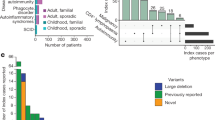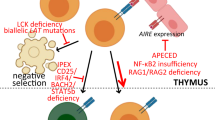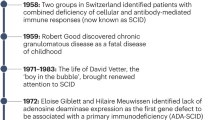Abstract
Primary immunodeficiency diseases consist of a group of more than 100 inherited conditions, mostly monogenic, predisposing individuals to different sets of infections, allergy, autoimmunity and cancer. Primary immunodeficiencies therefore represent exquisite models of various immunopathological settings. The identification of the associated genes, 100 so far, has generated a plethora of information about the immune system and spurred the analysis of many aspects of the development, function and regulation of both innate and adaptive immunity. These findings can potentially contribute to improved care of affected individuals by providing new diagnostic and/or therapeutic tools.
This is a preview of subscription content, access via your institution
Access options
Subscribe to this journal
Receive 12 print issues and online access
$209.00 per year
only $17.42 per issue
Buy this article
- Purchase on Springer Link
- Instant access to full article PDF
Prices may be subject to local taxes which are calculated during checkout



Similar content being viewed by others
References
Chapel, H., Geha, R. & Rosen, F. Primary immunodeficiency diseases: an update. Clin. Exp. Immunol. 132, 9–15 (2003).
Fischer, A. Primary immunodeficiency diseases: an experimental model for molecular medicine. Lancet 357, 1863–1869 (2001).
Buckley, R.H. Advances in immunology: primary Immunodeficiency diseases due to defects in lymphocytes. N. Engl. J. Med. 343, 1313–1324 (2000).
Bruton, O.C., Apt, L., Gitlin, D. & Janeway, C.A. Absence of serum gammaglobulins. AMA Am. J. Dis. Child 84, 632–636 (1952).
Good, R.A. Cellular immunology in a historical perspective. Immunol. Rev. 185, 136–158 (2002).
Person, R.E. et al. Mutations in proto-oncogene GFI1 cause human neutropenia and target ELA2. Nat. Genet. 34, 308–312 (2003).
Boocock, G.R. et al. Mutations in SBDS are associated with Shwachman-Diamond syndrome. Nat. Genet. 33, 97–101 (2003).
Stengaard-Pedersen, K. et al. Inherited deficiency of mannan-binding lectin-associated serine protease 2. N. Engl. J. Med. 349, 554–560 (2003).
Picard, C. et al. Pyogenic bacterial infections in humans with IRAK-4 deficiency. Science 299, 2076–2079 (2003).
Medvedev, A.E. et al. Distinct mutations in IRAK-4 confer hyporesponsiveness to lipopolysaccharide and interleukin-1 in a patient with recurrent bacterial infections. J. Exp. Med. 198, 521–531 (2003).
Dupuis, S. et al. Impaired response to interferon-α/β and lethal viral disease in human STAT1 deficiency. Nat. Genet. 33, 388–391 (2003).
Grimbacher, B. et al. Homozygous loss of ICOS is associated with adult-onset common variable immunodeficiency. Nat. Immunol. 4, 261–268 (2003).
Imai, K. et al. Human uracil-DNA glycosylase deficiency associated with profoundly impaired immunoglobulin class-switch recombination. Nat. Immunol. 4, 1023–1028 (2003).
Dadi, H., Simon, A.J. & Roifman, C.M. Effect of CD3delta deficiency on maturation of αβ and γδ T-cell lineages in severe combined immunodeficiency. N. Engl. J. Med. 349, 1821–1828 (2003).
Kofoed, E.M. et al. Growth hormone insensitivity associated with a STAT5b mutation. N. Engl. J. Med. 349, 1139–1147 (2003).
Courtois, G. et al. A hypermorphic IκBα mutation is associated with autosomal dominant anhidrotic ectodermal dysplasia and T cell immunodeficiency. J. Clin. Invest. 112, 1108–1115 (2003).
Feldmann, J. et al. Munc 13-4 is essential for fusion competence of cytolytic granules and its defect causes a form of familial hemophagocytic lymphohistiocytosis (FHL3). Cell 115, 461–73 (2003).
Ramoz, N. et al. Mutations in two adjacent novel genes are associated with epidermodysplasia verruciformis. Nat. Genet. 32, 579–581 (2002).
Hernandez, P.A. et al. Mutations in the chemokine receptor gene CXCR4 are associated with WHIM syndrome, a combined immunodeficiency disease. Nat. Genet. 34, 70–74 (2003).
Conley, M.E., Rohrer, J., Rapalus, L., Boylin, E.C. & Minegishi, Y. Defects in early B-cell development: comparing the consequences of abnormalities in pre-BCR signaling in the human and the mouse. Immunol. Rev. 178, 75–90 (2000).
Notarangelo, L.D. & Hayward, A.R. X-linked immunodeficiency with hyper-IgM (XHIM). Clin. Exp. Immunol. 120, 399–405 (2000).
Ferrari, S. et al. Mutations of CD40 gene cause an autosomal recessive form of immunodeficiency with hyper IgM. Proc. Natl. Acad. Sci. USA 98, 12614–12619 (2001).
Muramatsu, M. et al. Specific expression of activation-induced cytidine deaminase (AID), a novel member of the RNA-editing deaminase family in germinal center B cells. J. Biol. Chem. 274, 18470–18476 (1999).
Revy, P. et al. Activation-induced cytidine deaminase (AID) deficiency causes the autosomal recessive form of the hyper-IgM syndrome (HIGM2). Cell 102, 565–575 (2000).
Muramatsu, M. et al. Class switch recombination and somatic hypermutation require activation-induced cytidine deaminase (AID), a member of RNA editing cytidine deaminase family. Cell 102, 553–563 (2000).
Honjo, T., Kinoshita, K. & Muramatsu, M. Molecular mechanism of class switch recombination: linkage with somatic hypermutation. Annu. Rev. Immunol. 20, 165–196 (2002).
Petersen-Mahrt, S.K., Harris, R.S. & Neuberger, M.S. AID mutates E. coli suggesting a DNA deamination mechanism for antibody diversification. Nature 418, 99–104 (2002).
Chaudhuri, J. et al. Transcription-targeted DNA deamination by the AID antibody diversification enzyme. Nature 422, 726–730 (2003).
Pham, P., Bransteitter, R., Petruska, J. & Goodman, M.F. Processive AID-catalysed cytosine deamination on single-stranded DNA simulates somatic hypermutation. Nature 424, 103–107 (2003).
Ramiro, A.R., Stavropoulos, P., Jankovic, M. & Nussenzweig, M.C. Transcription enhances AID-mediated cytidine deamination by exposing single-stranded DNA on the nontemplate strand. Nat. Immunol. 4, 452–456 (2003).
Dickerson, S.K., Market, E., Besmer, E. & Papavasiliou, F.N. AID mediates hypermutation by deaminating single stranded DNA. J. Exp. Med. 197, 1291–1296 (2003).
Rada, C. et al. Immunoglobulin isotype switching is inhibited and somatic hypermutation perturbed in UNG-deficient mice. Curr. Biol. 12, 1748–1755 (2002).
Ta, V.T. et al. AID mutant analyses indicate requirement for class-switch-specific cofactors. Nat. Immunol. 4, 843–848 (2003).
Barreto, V., Reina-San-Martin, B., Ramiro, A.R., McBride, K.M. & Nussenzweig, M. C-terminal deletion of AID uncouples class switch recombination from somatic hypermutation and gene conversion. Cell 12, 501–508 (2003).
Imai, K. et al. Hyper-IgM syndrome type 4 with a B-lymphocyte intrinsic selective deficiency in immunoglobulin class switch recombination. J. Clin. Invest. 112, 136–142 (2003).
Kenter, A.L. Class-switch recombination: after the dawn of AID. Curr. Opin. Immunol. 15, 190–198 (2003).
Manis, J.P. & Alt, F.W. Novel antibody switching defects in human patients. J. Clin. Invest. 112, 19–22 (2003).
Bassing, C.H. et al. Increased ionizing radiation sensitivity and genomic instability in the absence of histone H2AX. Proc. Natl. Acad. Sci. USA 99, 8173–8178 (2002).
Celeste, A. et al. Genomic instability in mice lacking histone H2AX. Science 296, 922–927 (2002).
Harada, Y., Muramatsu, M., Shibata, T., Honjo, T. & Kuroda, K. Unmutated immunoglobulin M can protect mice from death by influenza virus infection. J. Exp. Med. 197, 1779–1785 (2003).
Frazer, I.H. et al. Potential strategies utilised by papillomavirus to evade host immunity. Immunol. Rev. 168, 131–142 (1999).
Allan, R.S. et al. Epidermal viral immunity induced by CD8α+ dendritic cells but not by Langerhans cells. Science 301, 1925–1928 (2003).
Zinkernagel, R.M. On differences between immunity and immunological memory. Curr. Opin. Immunol. 14, 523–536 (2002).
Hemmi, H. et al. Small anti-viral compounds activate immune cells via the TLR7 MyD88-dependent signaling pathway. Nat. Immunol. 3, 196–200 (2002).
Cooper, K.D., Androphy, E.J., Lowy, D. & Katz, S.I. Antigen presentation and T-cell activation in epidermodysplasia verruciformis. J. Invest. Dermatol. 94, 769–776 (1990).
Gorlin, R.J. et al. WHIM syndrome, an autosomal dominant disorder: clinical, hematological, and molecular studies. Am. J. Med. Genet. 91, 368–376 (2000).
Chae, K.M., Ertle, J.O. & Tharp, M.D. B-cell lymphoma in a patient with WHIM syndrome. J. Am. Acad. Dermatol. 44, 124–128 (2001).
Casal, J. & Tarrago, D. Immunity to Streptococcus pneumoniae: factors affecting production and efficacy. Curr. Opin. Infect. Dis. 16, 219–224 (2003).
Roy, S. et al. MBL genotype and risk of invasive pneumococcal disease: a case-control study. Lancet 359, 1569–1573 (2002).
Zonana, J. et al. A novel X-linked disorder of immune deficiency and hypohidrotic ectodermal dysplasia is allelic to incontinentia pigmenti and due to mutations in IKK-γ (NEMO). Am. J. Hum. Genet. 67, 1555–1562 (2000).
Doffinger, R. et al. X-linked ectodermal dysplasia anhydrotic and immunodeficiency is caused by hypo-functional NEMO mutations. Nat. Genet. 27, 277–285 (2001).
Jain, A. et al. Specific missense mutations in NEMO result in hyper-IgM syndrome with hypohydrotic ectodermal dysplasia. Nat. Immunol. 2, 223–228 (2001).
Li, Q. & Verma, I.M. NF-κB regulation in the immune system. Nat. Rev. Immunol. 2, 725–734 (2002).
Suzuki, N., Suzuki, S. & Yeh, W.C. IRAK-4 as the central TIR signaling mediator in innate immunity. Trends Immunol. 23, 503–506 (2002).
Pasparakis, M., Schmidt-Supprian, M. & Rajewsky, K. IκB kinase signaling is essential for maintenance of mature B cells. J. Exp. Med. 196, 743–752 (2002).
Kim, S. et al. The role of nuclear factor-B essential modulator (NEMO) in B cell development and survival. Proc. Natl. Acad. Sci. USA 100, 1203–1208 (2003).
Pomerantz, J.L. & Baltimore, D. Two pathways to NF-κB. Mol. Cell 10, 693–695 (2002).
Hull, K.M., Shoham, N., Chae, J.J., Aksentijevich, I. & Kastner, D.L. The expanding spectrum of systemic autoinflammatory disorders and their rheumatic manifestations. Curr. Opin. Rheumatol. 15, 61–69 (2003).
Catalfamo, M. & Henkart, P.A. Perforin and the granule exocytosis cytotoxicity pathway. Curr. Opin. Immunol. 15, 522–527 (2003).
Nagata, S. Fas ligand-induced apoptosis. Annu. Rev. Genet. 33, 29–55 (1999).
de Saint Basile, G. & Fischer, A. The role of cytotoxicity in lymphocyte homeostasis. Curr. Opin. Immunol. 13, 549–554 (2001).
Henter, J.I., Arico, M., Elinder, G., Imashuku, S. & Janka, G. Familial hemophagocytic lymphohistiocytosis. Primary hemophagocytic lymphohistiocytosis. Hematol. Oncol. Clin. North. Am. 12, 417–433 (1998).
Stepp, S.E. et al. Perforin gene defects in familial hemophagocytic lymphohistiocytosis. Science 286, 1957–1959 (1999).
Ménasché, G. et al. Mutations in RAB27A cause Griscelli syndrome associated with hemophagocytic syndrome. Nat. Genet. 25, 173–176 (2000).
Clark, R. & Griffiths, G.M. Lytic granules, secretory lysosomes and disease. Curr. Opin. Immunol. 15, 516–521 (2003).
Tchernev, V.T. et al. The Chediak-Higashi protein interacts with SNARE complex and signal transduction proteins. Mol. Med. 8, 56–64 (2002).
Fadeel, B., Orrenius, S. & Henter, J.I. Induction of apoptosis and caspase activation in cells obtained from familial haemophagocytic lymphohistiocytosis patients. Br. J. Haematol. 106, 406–415 (1999).
Van Parijs, L. & Abbas, A.K. Homeostasis and self-tolerance in the immune system: turning lymphocytes off. Science 280, 243–248 (1998).
Badovinac, V.P., Porter, B.B. & Harty, J.T. Programmed contraction of CD8+ T cells after infection. Nat. Immunol. 3, 619–626 (2002).
Matloubian, M. et al. A role for perforin in downregulating T-cell responses during chronic viral infection. J. Virol. 73, 2527–2536 (1999).
Huang, J.F. et al. TCR-Mediated internalization of peptide-MHC complexes acquired by T cells. Science 286, 952–954 (1999).
Hanon, E. et al. Fratricide among CD8+ T lymphocytes naturally infected with human T cell lymphotropic virus type I. Immunity 13, 657–664 (2000).
Landman-Parker, J., Le Deist, F., Blaise, A., Brison, O. & Fischer, A. Partial engraftment of donor bone marrow cells associated with long-term remission of haemophagocytic lymphohistiocytosis. Br. J. Haematol. 85, 37–41 (1993).
Rieux-Laucat, F. et al. Mutations in Fas associated with human lymphoproliferative syndrome and autoimmunity. Science 268, 1347–1349 (1995).
Fisher, G.H. et al. Dominant interfering Fas gene mutations impair apoptosis in a human autoimmune lymphoproliferative syndrome. Cell 81, 935–946 (1995).
Wang, J. et al. Inherited human Caspase 10 mutations underlie defective lymphocyte and dendritic cell apoptosis in autoimmune lymphoproliferative syndrome type II. Cell 98, 47–58 (1999).
Badovinac, V.P., Hamilton, S.E. & Harty, J.T. Viral infection results in massive CD8+ T cell expansion and mortality in vaccinated perforin-deficient mice. Immunity 18, 463–474 (2003).
Rathmell, J.C. & Goodnow, C.C. Autoimmunity. The Fas track. Curr. Biol. 5, 1218–1221 (1995).
Bjorses, P., Aaltonen, J., Horelli-Kuitunen, N., Yaspo, M.L. & Peltonen, L. Gene defect behind APECED: a new clue to autoimmunity. Hum. Mol. Genet. 7, 1547–1553 (1998).
The Finnish-German APECED Consortium. An autoimmune disease, APECED, caused by mutations in a novel gene featuring two PHD-type zinc-finger domains. Nat. Genet. 17, 349–403 (1997).
Ramsey, C. et al. Aire deficient mice develop multiple features of APECED phenotype and show altered immune response. Hum. Mol. Genet. 11, 397–409 (2002).
Anderson, M.S. et al. Projection of an immunological self shadow within the thymus by the aire protein. Science 298, 1395–1401 (2002).
Gambineri, E., Torgerson, T.R. & Ochs, H.D. Immune dysregulation, polyendocrinopathy, enteropathy, and X-linked inheritance (IPEX), a syndrome of systemic autoimmunity caused by mutations of FOXP3, a critical regulator of T-cell homeostasis. Curr. Opin. Rheumatol. 15, 430–435 (2003).
Liston, A., Lesage, S., Wilson, J., Peltonen, L. & Goodnow, C.C. Aire regulates negative selection of organ-specific T cells. Nat. Immunol. 4, 350–354 (2003).
Chin, R.K. et al. Lymphotoxin pathway directs thymic Aire expression. Nat. Immunol. 4, 1121–1127 (2003).
Notarangelo, L.D., Villa, A. & Schwarz, K. RAG and RAG defects. Curr. Opin. Immunol. 11, 435–442 (1999).
Bennett, C.L. et al. The immune dysregulation, polyendocrinopathy, enteropathy, X-linked syndrome (IPEX) is caused by mutations of FOXP3. Nat. Genet. 27, 20–21 (2001).
Wildin, R.S. et al. X-linked neonatal diabetes mellitus, enteropathy and endocrinopathy syndrome is the human equivalent of mouse scurfy. Nat. Genet. 27, 18–20 (2001).
Hori, S. Control of regulatory T cell development by the transcription factor Foxp3 . Science 299, 1057–1061 (2003).
Brunkow, M.E. et al. Disruption of a new forkhead/winged-helix protein, scurfin, results in the fatal lymphoproliferative disorder of the scurfy mouse. Nat. Genet. 27, 68–73 (2001).
Fontenot, J.D., Gavin, M.A. & Rudensky, A.Y. Foxp3 programs the development and function of CD4+CD25+ regulatory T cells. Nat. Immunol. 4, 330–336 (2003).
Khattri, R., Cox, T., Yasayko, S.A. & Ramsdell, F. An essential role for Scurfin in CD4+CD25+ T regulatory cells. Nat. Immunol. 4, 337–342 (2003).
Tommasini, A. et al. X-chromosome inactivation analysis in a female carrier of FOXP3 mutation. Clin. Exp. Immunol. 130, 127–130 (2002).
Baud, O. et al. Treatment of the immune dysregulation, polyendocrinopathy, enteropathy, X-linked syndrome (IPEX) by allogeneic bone marrow transplantation. N. Engl. J. Med. 344, 1758–1762 (2001).
von Boehmer, H. Dynamics of suppressor T cells: in vivo veritas. J. Exp. Med. 198, 845–849 (2003).
Casanova, J.L. & Abel, L. Genetic dissection of immunity to mycobacteria: the human model. Annu. Rev. Immunol. 20, 581–620 (2002).
Dai, Y. et al. Nonhomologous end joining and V(D)J recombination require an additional factor. Proc. Natl. Acad. Sci. USA 100, 2462–2467 (2003).
Moshous, D. et al. Partial T and B lymphocyte immunodeficiency and predisposition to lymphoma in patients with hypomorphic mutations in Artemis. J. Clin. Invest. 111, 381–387 (2003).
Layer, K. et al. Autoimmunity as the consequence of a spontaneous mutation in Rasgrp1. Immunity 19, 243–255 (2003).
Foster, C.B. et al. Host defense molecule polymorphisms influence the risk for immune-mediated complications in chronic granulomatous disease. J. Clin. Invest. 102, 2146–2155 (1998).
Loy, A.L. & Goodnow, C.C. Novel approaches for identifying genes regulating lymphocyte development and function. Curr. Opin. Immunol. 14, 260–265 (2002).
Paloneva, J. et al. Loss-of-function mutations in TYROBP (DAP12) result in a presenile dementia with bone cysts. Nat. Genet. 25, 357–361 (2000).
Acknowledgements
I thank G. de Saint Basile, A. Durandy, F. Le Deist, P. Revy and F. Rieux-Laucat (Institut National de la Santé et de la Recherche Médicale U429), whose contributions are discussed herein. I also thank M. Tiouri for her secretarial assistance.
Author information
Authors and Affiliations
Ethics declarations
Competing interests
The author declares no competing financial interests.
Rights and permissions
About this article
Cite this article
Fischer, A. Human primary immunodeficiency diseases: a perspective. Nat Immunol 5, 23–30 (2004). https://doi.org/10.1038/ni1023
Published:
Issue Date:
DOI: https://doi.org/10.1038/ni1023
This article is cited by
-
Dysbiosis and primary B-cell immunodeficiencies: current knowledge and future perspective
Immunologic Research (2023)
-
T Cell Repertoire Abnormality in Immunodeficiency Patients with DNA Repair and Methylation Defects
Journal of Clinical Immunology (2022)
-
Exploring genetic defects in adults who were clinically diagnosed as severe combined immune deficiency during infancy
Immunologic Research (2021)
-
Novel Mutations in RASGRP1 are Associated with Immunodeficiency, Immune Dysregulation, and EBV-Induced Lymphoma
Journal of Clinical Immunology (2018)
-
Hematopoietic stem cell gene therapy for the cure of blood diseases: primary immunodeficiencies
Rendiconti Lincei. Scienze Fisiche e Naturali (2018)



